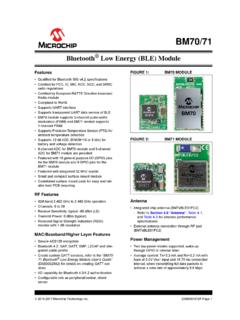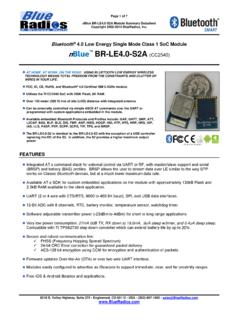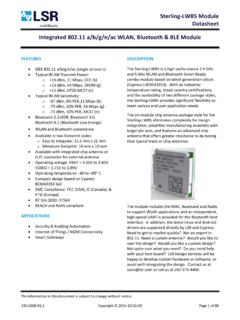Transcription of Bluetooth® low energy and the automotive transformation
1 bluetooth low energy and the automotive transformationKhanh Tuan LeSystems EngineerTexas InstrumentsBluetooth low energy and the automotive transformation 2 September 2017 IntroductionThe automotive industry has been experiencing a tremendous transformation . For many consumers, cars are evolving from being just a transport medium to becoming an integral part of their digital lives. The modern automobile is a technology hub hosting wireless technologies like GPS, bluetooth , Wi-Fi , near field communication (NFC) and cellular (4G/5G), all serving as complementary connectivity options to help enhance functionality, user safety and of the latest developments in the midst of this transformation is automotive original equipment manufacturers (OEMs) embrace of bluetooth low energy technology (Figure 1) because of its technical merits and embedded presence in smartphones.
2 The intent is to enable consumers to use their bluetooth low energy -equipped smartphones and portable devices to manage applications revolving around in-vehicle control, personalized infotainment, vehicle diagnostics, car access, vehicle sharing and piloted parking. As the industry also evolves to be greener, replacing cables using low-power wireless technology is another major potential for bluetooth low 1. bluetooth low energy -enabled applications as part of the automotive low energy and the automotive transformation 3 September 2017 bluetooth low energy in automotive applicationsEmbedded into modern smartphones, wearables and tablets.
3 bluetooth low energy technology enables consumers to use their own mobile devices to interact with any bluetooth low energy -enabled low energy is attractive for automotive applications because of its ability to work with applications on now-ubiquitous idea behind virtually connecting smartphones with automobiles is to increase driver and passenger convenience and to bring a consumer s personalized entertainment and connected experience into the car environment safely and of bluetooth low energy -enabled automotive applications revolving around smartphones include: Smart vehicle access.
4 The driver s smartphone functions as a virtual key, with secured information recognized by the vehicle that allows specific functions (lock/unlock/engine start) to occur. Bidirectional communications between the phone and the car take place via bluetooth low energy . Car sharing. Smart vehicle access using a dynamic virtual key facilitates a secure and convenient way to lend and rent cars. A smartphone app receives the necessary codes to access the assigned vehicle. When the driver approaches the vehicle, bluetooth low energy communications authenticate the codes on the smartphone, enabling drivers to access certain functions.
5 In addition to function access, the time and duration of access are also pre-configurable. Vehicle diagnostics information. Vehicle diagnostics information such as tire pressure, fuel level, battery status and temperature can be sent from the vehicle directly or in some cases through a standard key fob (for security or longer range) to a smartphone using bluetooth low energy . Smartphones can also display diagnostic information to help drivers understand cryptic warning lights. Driver assistance and personalization. The vehicle can automatically recognize the smartphone as the driver approaches and activate interior and/or exterior lighting, personalize seat positions, and adjust seating, ventilation and air conditioning (HVAC) settings and infotainment preferences.
6 Piloted/assisted/remote parking. The idea behind it is simple: the user exits the vehicle, pulls out the smartphone and activates an app and the car drives itself off to a parking spot nearby. Piloted parking is a very efficient and convenient way to park a car in tight parking spaces where manual parking is difficult and getting in and out of the car is practically impossible due to space limitations. The sensing and maneuvering operations required to self-park involve many sensors located around the vehicle, as well as embedded intelligence inside the vehicle.
7 Communication between the car and a smartphone app via bluetooth low energy can activate and monitor the parking process. (Typically, a certain drive motion on a smartphone touchscreen is required to maintain the process; if the driver lifts their finger from the screen or the drive motion ceases, the vehicle will immediately stop.)Determining position or location finding with use-case-dependent requirements for resolution and accuracy will be tremendously important for smartphone-assisted and other automotive applications in and around connected cars. The bluetooth low energy and the automotive transformation 4 September 2017most well-known techniques for location finding include estimating the received signal strength (RSSI) or time of flight (TOF) in order to determine the distance between the transmitter and the receiver, and estimation of the angle of arrival (AOA) or angle of departure (AOD), which can further extend to triangulation.
8 Location finding with high accuracy and resolution in real wireless environments is highly challenging, and satisfactory solutions will need to combine several or all of these of position can be used in a wide range of applications, including relay attack prevention and customization of certain functions based on the driver s position. Although bluetooth low energy doesn t inherently include location features today, both the bluetooth low energy specification and innovative bluetooth low energy -based automotive systems will likely evolve to address location challenges in the near low energy functionality of the smart vehicle access including Passive Entry Passive Start (PEPS) and other smartphone-related applications (piloted parking, car sharing, etc.)
9 Can typically be implemented in the vehicle as part of the Body Control Module (BCM), Electronic Control Unit (ECU), telematics module or similar. These designs can use a dual-mode bluetooth or single-mode bluetooth low energy integrated circuit (IC).Figure 2 shows an example of bluetooth low energy -enabled car access use case, where the bluetooth functionality on the car side is implemented in the BCM and the bluetooth -equipped key can be either a traditional key fob, a wearable or a cables is another potential application of bluetooth low energy . Currently, most vehicle sensors connect to ECUs with physical wires.
10 As the complexity of vehicles increases, the number of wires needed to connect sensors leads to increased weight and cost. Furthermore, wired connections can limit sensor locations and hence the range of wireless sensors can help reduce vehicle weight and save fuel consumption. Replacing cables between mirrors, windows and the vehicle trunk with bluetooth low energy technology can also improve connection reliability and offer manufacturing flexibility by eliminating physical connections. Figure 3 on the following page illustrates how the bluetooth low energy wireless link can replace the wires between the window, or mirrors and the 2.















